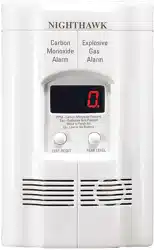Documents: Go to download!
User Manual
- User Manual - (English)
- User Guide - (English)
- Warranty - (English)
- Application Guide - (English)
- Specification Sheet - (English)
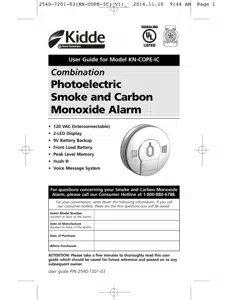
- Product View
- Features
- Operating and Installation Instructions
- Battery Replacement
- General Maintenance
Table of contents
Product View
FRONT
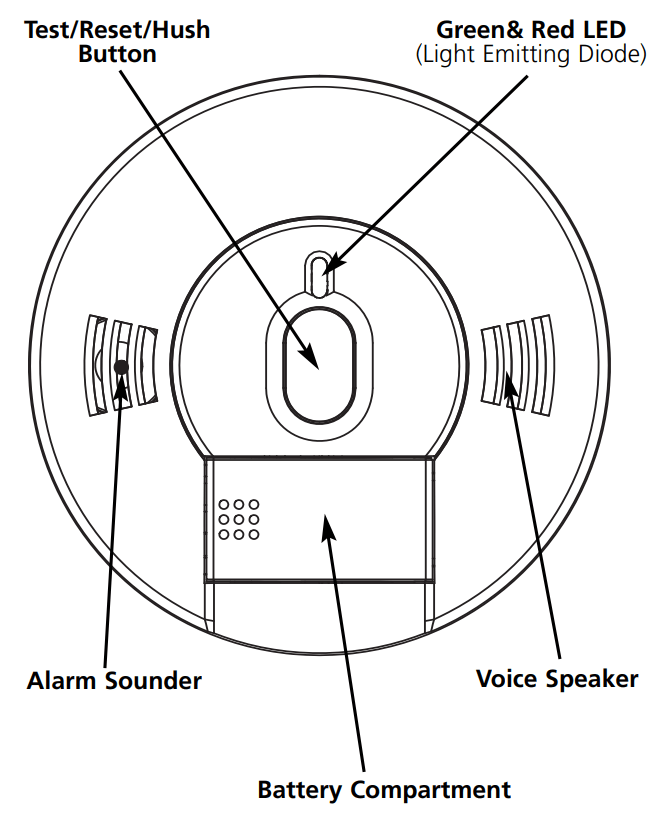
BACK
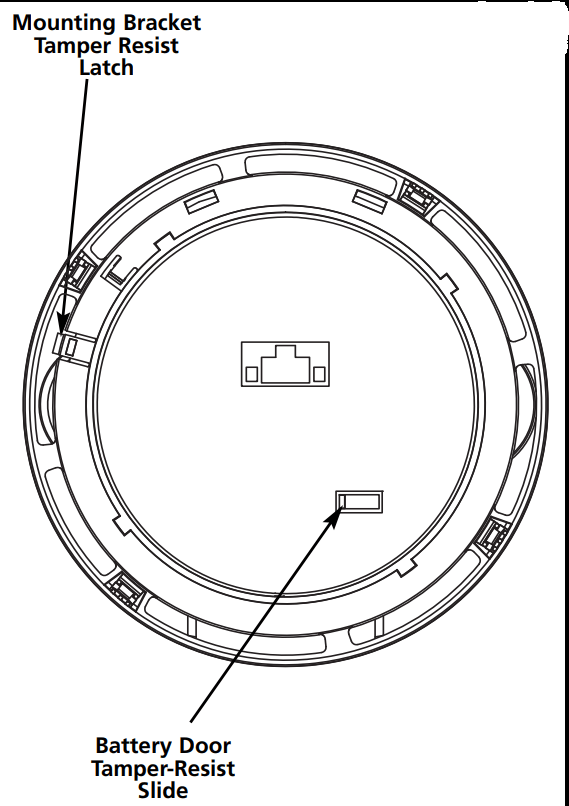
Features
Independent smoke and carbon monoxide sensors.
Smoke alarm takes precedence when both smoke and carbon monoxide are present.
Alarm/Voice message warning system that alerts you of the following conditions in the manner described below, thus eliminating any confusion over which alarm is sounding:
- FIRE: The alarm/voice pattern is three long alarm beeps followed by the verbal warning message “FIRE! FIRE!”. This pattern is repeated until the smoke is eliminated. The red LED light will flash while in alarm/voice mode.
- CARBON MONOXIDE: The alarm/voice pattern is four short alarm beeps followed by the verbal warning message “WARNING! CARBON MONOXIDE!”. After four minutes the alarm/voice pattern will sound once every minute until the unit is reset, or the CO eliminated. The red LED light will flash while in alarm/voice mode.
- LOW BATTERY: When the batteries are low and need replacing the red LED light will flash and the unit will “chirp” one time, followed by the warning message “LOW BATTERY”. This cycle will occur once every minute for the first hour. After the first hour the red LED light will continue to flash every minute accompanied by the “chirp” only sound. The voice message “LOW BATTERY” will sound once every fifteen minutes during the “chirp” only cycle. This will continue for at least seven days.
Voice Message System that alerts user to the following conditions:
- System announces “HUSH MODE ACTIVATED” when the unit is first put into HUSH Mode.
- System announces “HUSH MODE CANCELLED” when unit resumes normal operation after Hush Mode has been cancelled.
- System announces “CAUTION, CARBON MONOXIDE PREVIOUSLY DETECTED” when the unit has detected CO concentrations of 100 ppm or higher.
- System announces “PUSH TEST BUTTON” when the unit is powered up, reminding user to activate the Test Button.
One “chirp” every 30 seconds is an indication that the alarm is malfunctioning.
After ten (10) years of cumulative power up, this unit will “chirp” every 30 seconds. This is an "operational end of life" feature which will indicate that it is time to replace the alarm.
Loud 85 decibel alarm
HUSH Control Feature that silences the unit during nuisance alarm situations.
Oversized test button for easy activation
Test button performs the following functions:
- Tests the units electronics and verifies proper unit operation
- Resets the unit during CO alarm
- Peak Level Memory
- Activates or cancels Hush® Feature
Mounting bracket designed for easy orientation of the unit
Green and red LED lights that indicate normal operation and alarm status
- Green Light: The green LED will be lit continuously (AC power), or flash every 30 seconds (battery power) to indicate the unit is operating properly. In HUSH® mode the LED blinks every 2 seconds and once per second if it is the initiating alarm.
- Red Light: When a dangerous level of smoke or carbon monoxide is detected the red LED light will flash and the corresponding alarm pattern (depending on the source) will sound. If the unit malfunctions, the red LED light will flash and the unit will chirp every 30 seconds indicating a system problem.
Powered by 120V AC (60 Hz, 75 mA max) wire-in connector and is also equipped with a 9V battery backup.
Can be interconnected to other Kidde/Nighthawk brand smoke and CO alarms
Tamper Resist Feature that deters children and others from removing the battery or alarm
Smoke Alarm
The smoke alarm monitors the air for products of combustion that are produced when something is burning or smoldering. When smoke particles in the smoke sensor reach a specified concentration, the alarm/voice message warning system will sound, and be accompanied by the flashing red LED light. The smoke alarm takes precedence when both smoke and carbon monoxide are present.
NFPA 72 states: Life safety from fire in residential occupancies is based primarily on early notification to occupants of the need to escape, followed by the appropriate egress actions by those occupants. Fire warning systems for dwelling units are capable of protecting about half of the occupants in potentially fatal fires. Victims are often intimate with the fire, too old or young, or physically or mentally impaired such that they cannot escape even when warned early enough that escape should be possible. For these people, other strategies such as protection-in-place or assisted escape or rescue are necessary.
- Leading authorities recommend that both ionization and photoelectric smoke alarms be installed to help insure maximum detection of the various types of fires that can occur within the home. Ionization sensing alarms may detect invisible fire particles (associated with fast flaming fires) sooner than photoelectric alarms. Photoelectric sensing alarms may detect visible fire particles (associated with slow smoldering fires) sooner than ionization alarms.
- A battery powered alarm must have a battery of the specified type, in good condition and installed properly.
- AC powered alarms (without battery backup) will not operate if the AC power has been cut off, such as by an electrical fire or an open fuse.
- Smoke alarms must be tested regularly to make sure the batteries and the alarm circuits are in good operating condition.
- Smoke alarms cannot provide an alarm if smoke does not reach the alarm. Therefore, smoke alarms may not sense fires starting in chimneys, walls, on roofs, on the other side of a closed door or on a different floor.
- If the alarm is located outside the bedroom or on a different floor, it may not wake up a sound sleeper.
- The use of alcohol or drugs may also impair one’s ability to hear the smoke alarm. For maximum protection, a smoke alarm should be installed in each sleeping area on every level of a home.
- Although smoke alarms can help save lives by providing an early warning of a fire, they are not a substitute for an insurance policy. Home owners and renters should have adequate insurance to protect their lives and property.
Carbon Monoxide (CO) Alarm
The carbon monoxide (CO) alarm monitors the air for the presence of CO. It will alarm when there are high levels of CO present, and when there are low levels of CO present over a longer period of time. When a CO condition matches either of these situations, the alarm/voice message warning system will sound, and be accompanied by the flashing red LED light. The carbon monoxide sensor uses an electrochemical technology.
CAUTION: This alarm will only indicate the presence of carbon monoxide gas at the sensor. Carbon monoxide gas may be present in other areas.
Individuals with medical problems may consider using warning devices which provide audible and visual signals for carbon monoxide concentrations less than 30 ppm.
Operating and Installation Instructions
Step 1: Installation Guide:
IMPORTANT: THIS ALARM MUST BE MOUNTED ON A CEILING OR WALL. IT WAS NOT DESIGNED FOR USE AS A TABLETOP DEVICE! INSTALL ONLY AS DETAILED!
A. Recommended Installation Locations:
Kidde recommends the installation of a Smoke/CO Alarm in the following locations. For maximum protection we suggest an alarm be installed on each level of a multilevel home, including every bedroom, hallways, finished attics and basements. Put alarms at both ends of bedroom, hallway or large room if hallway or room is more than 30 ft (9.1m) long. If you have only one alarm, ensure it is placed in the hallway outside of the main sleeping area, or in the main bedroom. Verify the alarm can be heard in all sleeping areas.
Locate an alarm in every room where someone sleeps with the door closed. The closed door may prevent an alarm not located in that room from waking the sleeper. Smoke, heat and combustion products rise to the ceiling and spread horizontally.
Mounting the alarm on the ceiling in the center of the room places it closest to all points in the room. Ceiling mounting is preferred in ordinary residential construction. When mounting an alarm on the ceiling, locate it at a minimum of 4” (10cm) from the side wall. If installing the alarm on the wall, use an inside wall with the top edge of the alarm at a minimum of 4” (10cm) and a maximum of 12” (30.5cm) below the ceiling.
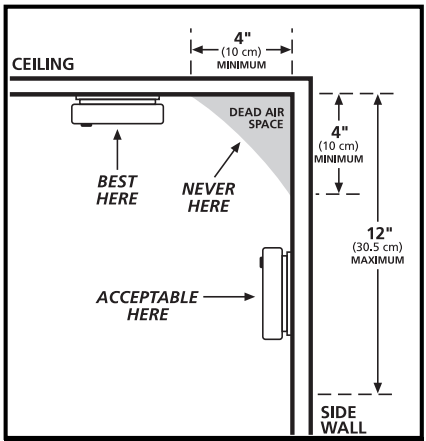
Sloped Ceiling Installation:
The following information is from the National Fire Protection Association and is listed in Fire Code 72. Install Smoke Alarms on sloped, peaked or cathedral ceilings at, or within 3 ft (0.9m) of the highest point (measured horizontally). NFPA 72 states “Smoke alarms in rooms with ceiling slopes greater than 1 ft to 8 ft (.3 m-2.4 m) horizontally shall be located on the high side of the room”.
NFPA 72 states “A row of alarms shall be spaced and located within 3 ft (0.9 m) of the peak of the ceiling measured horizontally”

Mobile Homes:
Modern mobile homes have been designed and built to be energy efficient. Install Smoke/CO alarms as recommended previously. In older mobile homes that are not well insulated, extreme heat or cold can be transferred from the outside to the inside through poorly insulated walls and roof. This may cause a thermal barrier, which can prevent smoke from reaching an alarm mounted on the ceiling. In such mobile homes install your Smoke/CO Alarm on an inside wall with the top edge of the alarm at a minimum of 4 inches (10cm) and a maximum of 12 inches (30.5cm) below the ceiling. If you are not sure about the insulation in your mobile home, or if you notice that the outer walls and ceiling are either hot or cold, install your alarm on an inside wall ONLY!
B. Where Not to Install:
Do not install in garages, kitchens, furnace rooms or bathrooms! INSTALL AT LEAST 5 FEET AWAY FROM ANY FUEL BURNING OR COOKING APPLIANCE
Do not install within 3 ft (.9m) of the following: The door to a kitchen, or a bathroom that contains a tub or shower, forced air supply ducts used for heating or cooling, ceiling or whole house ventilating fans, or other high air flow areas. Avoid excessively dusty, dirty or greasy areas. Dust, grease or household chemicals can contaminate the alarm’s sensors, causing the alarm to not operate properly.
Place the alarm where drapes or other objects will not block the sensors. Smoke and CO must be able to reach the sensors to accurately detect these conditions. Do not install in peaks of vaulted ceilings, “A” frame ceilings or gabled roofs. Keep out of damp and humid areas.
Install at least one (1) foot away from fluorescent lights, electronic noise may cause nuisance alarms. Do not place in direct sunlight and keep out of insect infested areas. Extreme temperatures will effect the sensitivity of the Smoke/CO Alarm. Do not install in areas where the temperature is colder than 40º Fahrenheit (4.4º Celsius) or hotter than 100º Fahrenheit (37.8º Celsius), such as garages and unfinished attics. Do not install in areas where the relative humidity (RH) is below 10%, or above 95%, non-condensing. Place away from doors and windows that open to the outside.
Smoke alarms are not to be used with detector guards unless the combination (alarm and guard) has been evaluated and found suitable for that purpose.
Step 2: Wiring Instructions:
Wiring Requirements
- This smoke alarm should be installed on a U.L. listed or recognized junction box. All connections should be made by a qualified electrician and all wiring used shall be in accordance with articles 210 and 300.3(B) of the U.S. National Electrical Code ANSI/NFPA 70, NFPA 72 and/or any other codes having jurisdiction in your area. The multiple station interconnect wiring to the alarms must be run in the same raceway or cable as the AC power wiring. In addition, the resistance of the interconnect wiring shall be a maximum of 10 ohms.
- The appropriate power source is 120 Volt AC Single Phase supplied from a non-switchable circuit, which is not protected by a ground fault interrupter.
WARNING: The alarm cannot be operated from power derived from a square wave, modified square wave or modified sine wave, inverter. These types of inverters are sometimes used to supply power to the structure in off grid installations, such as solar or wind derived power sources. These power sources produce high peak voltages that will damage the alarm.
WIRING INSTRUCTIONS FOR AC QUICK CONNECT HARNESS
CAUTION! TURN OFF THE MAIN POWER TO THE CIRCUIT BEFORE WIRING THE ALARM.
- For alarms that are used as single station, DO NOT CONNECT THE RED WIRE TO ANYTHING. Leave the red wire insulating cap in place to make certain that the red wire cannot contact any metal parts or the electrical box.
- When alarms are interconnected, all interconnected units must be powered from a single circuit.
- A maximum of 24 Kidde Safety devices may be interconnected in a multiple station arrangement. The interconnect system should not exceed the NFPA interconnect limit of 12 smoke alarms and/or 18 alarms total (smoke, CO, Smoke/CO Combination, heat, etc.). This Smoke/CO combination alarm must be counted as a smoke alarm when determining the number of units on an interconnect line. With 18 alarms interconnected, it is still possible to interconnect up to a total of 6 remote signaling devices and /or relay modules.
- The maximum wire run distance between the first and last unit in an interconnected system is 1000 feet.
- Improper connection may result in damage to the alarm, failure to operate, or a shock hazard.

WIRES ON ALARM HARNESS CONNECTED TO
Black - Hot side of AC line
White - Neutral side of AC line
Red - Interconnect lines (red wires) of other units in the multiple station set up
- Make certain alarms are wired to a continuous (nonswitched) power line. NOTE: Use standard UL Listed household wire (as required by local codes) available at all electrical supply stores and most hardware stores
Step 3: Mounting Instructions
CAUTION: YOUR SMOKE/CO ALARM IS SEALED AND THE COVER IS NOT REMOVABLE!
1. To help identify the date to replace the unit, a label has been affixed to the side of the alarm. Write the “Replace by” date (10 years from initial power up) in permanent marker on the label.
2. Remove the mounting bracket from the back of the alarm by holding the mounting bracket and twisting the alarm in the direction indicated by the “OFF”arrow on the alarm cover.
3. After selecting the proper location for your Smoke/CO Alarm and wiring the AC QUICK CONNECT harness as described in the WIRING INSTRUCTIONS, attach the mounting bracket to the electrical box. To ensure aesthetic alignment of the alarm with the hallway, or wall, the “A” line on the mounting bracket must be parallel with the hallway when ceiling mounted, or horizontal when wall mounted.
4. Pull the AC QUICK CONNECTOR through the center hole in the mounting bracket and secure the bracket, making sure that the mounting screws are positioned in the small ends of the keyholes before tightening the screws.
5. Plug the AC QUICK CONNECTOR into the back of the alarm, making sure that the locks on the connector snap into place. Then push the excess wire back into the electrical box through the hole in the center of the mounting bracket.
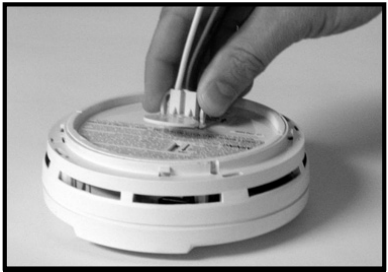
6. Install the alarm on the mounting bracket and rotate the alarm in the direction of the “ON” arrow on the cover until the alarm ratchets into place (this ratcheting function allows for aesthetic alignment). Note: The alarm will mount to the bracket in 4 positions (every 90 degrees).
7. Turn on the AC power. The green AC Power On Indicator should be lit when the alarm is operating from AC power.
8. Two labels are included with your alarm. They have important information on what to do in case of an alarm. Add the phone number of your emergency service provider in the space provided. Place one label next to the alarm after it is mounted, and one label near a fresh air source such as a door or window.
9. Pull the Battery Pull Tab (yellow tab protruding from unit) completely out of unit. This will automatically connect the battery.
Step 4: Testing the Alarm
CAUTION: Due to the loudness (85 decibels) of the alarm, always stand an arms length away from the unit when testing.
The test/reset button has four purposes. It tests the unit’s electronics, resets the CO alarm, activates the HUSH feature, and activates the Peak Level Memory Feature.
After installation, TEST THE UNIT’S ELECTRONICS by pressing and releasing the test/reset button. A series of beeps will sound, followed by the message “Fire! Fire!” then another two series of beeps and the message “WARNING! CARBON MONOXIDE!” followed by 4 additional short beeps.
Weekly testing is required! If at anytime it does not perform as described, verify power is connected correctly and that the battery doesn’t need replacing. Clean dust and other buildup off the unit.
Interconnect Feature
- Your Combination Smoke/CO Alarm can be interconnected to other multiple station Kidde, Nighthawk, Kidde/Fyrnetics, and Kidde/FireX products:
- When compatible smoke alarms and heat alarms are interconnected to your Smoke/CO Alarm, they will only respond to a smoke related event.
- When mixing compatible models with battery backup with models without battery backup, be advised that the models without battery backup will not respond during an AC power failure.
- This unit is only approved to interconnect with other Kidde/Nighthawk products. It is NOT approved to interconnect with any other brand of detection product.
- This alarm is interconnect compatible with the following alarms and accessories:
Smoke alarms: 1235, 1275, 1276, 1285, i12020, i12020A, i12040, i12040A, i12060, i12060A, i4618, i4618A, KN-SMFM-I, RF-SM-ACDC, PE120, P12040, Pi2000, Pi2010, i12010S
CO alarms: KN-COB-IC, KN-COP-IC, KN-COPF-I
Combo alarms: KN-COSM-I, KN-COSM-IB, i12010SCO
Heat alarm: HD135F
Relay modules: SM120X, CO120X
Strobe Light: SL177i, SLED177i
HUSH® Control Feature
The HUSH® feature has the capability of temporarily desensitizing the smoke alarm circuit for approximately 10 minutes. This feature is to be used only when a known alarm condition, such as smoke from cooking, activates the alarm.
You can put your Smoke/CO Alarm in HUSH® mode by pushing the test/reset button. If the smoke is not too dense, the alarm will silence immediately, the unit will verbally announce “HUSH MODE ACTIVATED”, and the green LED will flash every 2 seconds for approximately 10 minutes.
This indicates that the smoke alarm is in a temporarily desensitized condition. Your Smoke/CO Alarm will automatically reset after approximately 10 minutes. When the unit returns to normal operation after being in HUSH® mode, it will verbally announce “HUSH MODE CANCELLED”, and sound the alarm if smoke is still present. The HUSH® feature can be used repeatedly until the air has been cleared of the condition causing the alarm. While the unit is in HUSH® mode, pushing the test/reset button on the alarm will also end the HUSH® period.
Operating Instructions
NOTE: DENSE SMOKE WILL OVERRIDE THE HUSH® CONTROL FEATURE AND SOUND A CONTINUOUS ALARM.
CAUTION: BEFORE USING THE ALARM HUSH® FEATURE, IDENTIFY THE SOURCE OF THE SMOKE AND BE CERTAIN A SAFE CONDITION EXISTS.
Reset Feature
If the Smoke/CO Alarm is sounding a CO alarm, pressing the test/reset button will initiate a test/reset. If the CO condition that caused the alert continues, the alarm will reactivate.
Alarm/Peak Level Memory
If the green LED is blinking once every 16 seconds, the unit has detected a hazardous condition. If the unit has detected a CO alarm or a CO level of 100 PPM or greater, pushing the Test/Reset button will result in a voice message “Caution, carbon monoxide previously detected”. Peak level also happens if the unit detects smoke and then comes out of alarm. However, there is no voice message if the unit is in peak level due to smoke. When the Test/Reset button is pushed, the unit will produce three rapid beeps. Pushing the test/reset button resets the memory. It’s also reset when the power is removed.
LED Indicator Operation
Red LED
The red LED will flash in conjunction with the alarm sounder. Therefore, the red LED will flash during a smoke alarm, a CO alarm, a low battery mode chirp and a unit error mode chirp.
Green LED
The green LED will flash as described below under the following conditions:
Standby Condition (powered by AC and battery backup): The LED will be constantly on.
Standby Condition (powered by only battery backup): The LED will flash every 30 seconds.
Alarm Condition: The LED will flash every second signifying that the alarm sensed a smoke or CO hazard. If the green LED is not flashing every second while sounding an alarm, then the alarm is acting as a remote sounder and an alarm in another area is initializing the warning.
HUSH MODE Condition: The LED will flash every 2 seconds while the alarm is in HUSH mode.
Alarm Memory: The LED blinks once every 16 seconds to indicate a hazardous condition was previously detected.
Tamper Resist Features
To make your smoke/CO alarm tamper resistant, two tamper resist features have been provided. The first is used to discourage removal of the alarm while the second is for the battery. To activate the mounting bracket tamper resist feature break off the four posts in the square holes in the trim ring. When the posts are broken off, the tamper resist tab on the base is allowed to engage the mounting bracket. Rotate the alarm onto the mounting bracket until you hear the tamper resist tab snap into place, locking the alarm on the mounting bracket. Using the tamper resist feature will help deter children and others from removing the alarm from bracket.
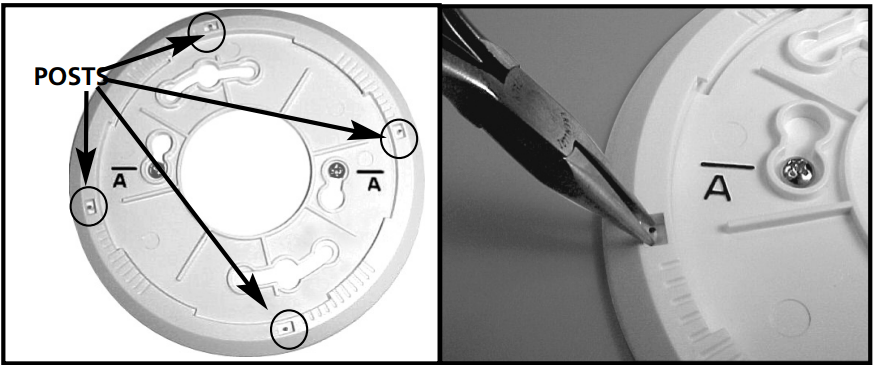
NOTE: To remove the alarm when the tamper resist tab is engaged, press down on the tamper resist tab, and rotate the alarm off of the bracket.
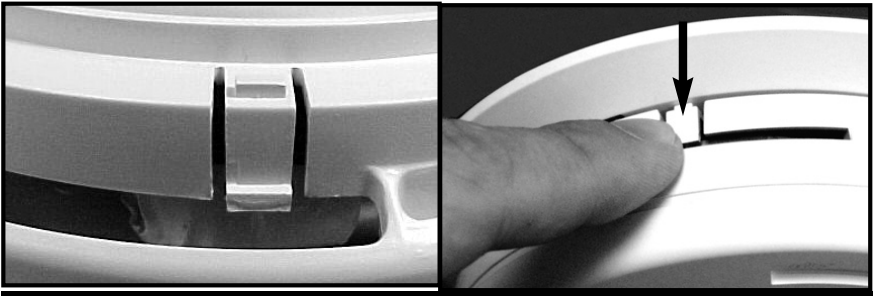
This alarm also has a battery carrier tamper resist feature, which helps prevent the battery carrier from being opened.
This feature is effective in preventing the removal of the battery from this device (which will render the unit inoperable during the loss of AC power).
To activate the battery carrier tamper resist feature, remove the unit from the trim plate, disconnect the AC quick connector and locate the small cut-out in the middle of the product label on the back of the unit. With a small screwdriver, or similar tool, slide the switch towards the top of the label. The tamper resist feature is now active and the battery carrier can not be opened until the tamper resist feature is deactivated.
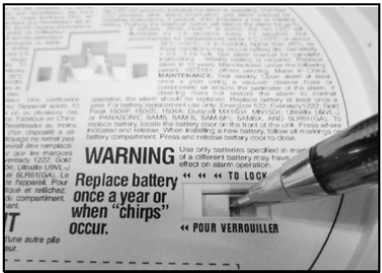
NOTE: Before activating the battery carrier tamper resist feature, make sure a fresh battery is installed in the unit and that the battery carrier is properly closed. If the battery carrier tamper resist feature is activated while the battery carrier is open, the battery carrier will not close and the unit will be inoperable during the loss of AC power.
To deactivate the battery carrier tamper resist, in order to change the smoke alarm battery, remove the unit from the trim plate, disconnect the AC quick connector and locate the small cut-out in the middle of the product label. Using a screwdriver, or similar tool, slide the switch towards the bottom of the product label. The battery carrier can now be opened and the battery changed.
CO Alarm Response Time
Never restart the source of a CO problem until it has been fixed. NEVER IGNORE THE ALARM!
The CO sensor meets the alarm response time requirements of UL standard 2034. Standard alarm times are as follows:
At 70 PPM, the unit must alarm within 60-240 minutes.
At 150 PPM, the unit must alarm within 10-50 minutes.
At 400 PPM, the unit must alarm within 4-15 minutes.
This carbon monoxide alarm is designed to detect carbon monoxide gas from ANY source of combustion. It is NOT designed to detect any other gas.
Fire Departments, most utility companies and HVAC contractors will perform CO inspections, some may charge for this service. It’s advisable to inquire about any applicable fees prior to having the service performed. Kidde will not pay for, or reimburse, the owner or user of this product, for any repair or dispatch calls related to the alarm sounding.
Alarm Removal
Remove the alarm from the mounting bracket by rotating the alarm in the direction of the “OFF” arrow on the cover
Battery Replacement
To disconnect the AC power harness, squeeze the locking arms on the sides of the Quick Connector while pulling the connector away from the bottom of the alarm.
If any form of battery failure is detected the red LED light will flash and the unit will “chirp” one time, followed by the warning message “LOW BATTERY”. This cycle will occur once every minute for the first hour. After the first hour, the red LED light will continue flashing accompanied by the chirp only sound every 60 seconds. The voice message “LOW BATTERY” will sound once every fifteen minutes during the chirp only cycle, and will continue for at least seven days.
If the red LED light flashes along with a chirp every 30 seconds, and is not followed by the voice message “LOW BATTERY” as described above, your unit has malfunctioned.
CAUTION: YOUR SMOKE/CO ALARM IS SEALED AND THE COVER IS NOT REMOVABLE!
Note: If battery carrier tamper resist feature has been activated it will need to be deactivated in order to change the battery. Refer to section 3 “Battery Carrier Tamper Resist Feature” for instructions.
To replace or install the batteries press on the battery carrier and then release to allow the carrier to pop open. The battery can then be pulled out of the carrier. When installing a new battery into the carrier, make sure the battery terminals are exposed and that the polarity matches the markings printed on the battery carrier. Completely press the battery carrier down into the alarm and release, the battery carrier will lock into the closed position.
A missing or improperly installed battery will prevent the battery carrier from closing and result in improper alarm operation.
This smoke alarm uses a 9V battery. A fresh battery should last for one year under normal operating conditions.
Replace batteries with one of the following approved brands: Duracell MN1604, MX1604, Energizer 522 and Gold Peak 1604A. These batteries can be purchased at your local retailer.
WARNING! Use only the batteries specified. Use of different batteries may have a detrimental effect on the Smoke/CO alarm. A good safety measure is to replace the battery at least once a year, or at the same time you change your clocks for daylight saving time.
Alarm Replacement
Ten years after initial power-up, this unit will “chirp” twice every 30 seconds to indicate that it is time to replace the alarm. A label has been provided on the side of the alarm that has “Replace by” printed on it. Write the replace by date on the label. The date written on the label should be ten (10) years after the alarm was initially powered.
This alarm does have end of life Hush® which allows you to silence the trouble chirp for two days giving you exrtra time to replace the unit at a more convenient time. To activate, press the test/reset button. While in the End of Life Hush® mode, will still detect CO and Smoke. This feature can only be used for 30 days from the time the unit first indicates end of life. At the end of the 30 day period the alarm cannot be hushed and must be replaced immediately.
General Maintenance
To keep your Smoke/CO Alarm in good working order, please follow these simple steps:
- Verify unit alarm, lights and battery operation by pushing the test/reset button once a week.
- Clean your alarm monthly using compressed air or a vacuum cleaner hose and vacuuming or blowing air through the openings around the perimeter of the alarm. If cleaning does not restore your alarm to normal operation the alarm should be replaced.
REINSTALL IMMEDIATELY AFTER CLEANING AND THEN TEST USING THE TEST/RESET BUTTON!
Never use detergent or other solvents to clean the unit.
Avoid spraying air freshener, hair spray, or other aerosols near the Smoke/CO Alarm.
Do not paint the unit. Paint will seal the vents and interfere with the sensor’s ability to detect smoke and CO. Never attempt to disassemble the unit or clean inside. This action will void your warranty. Move the Smoke/CO Alarm and place in another location prior to performing any of the following:
Staining or stripping wood floors or furniture
Painting
Wall papering
Using adhesives
Storing the unit in a plastic bag during any of the above projects will protect the sensors from damage. Do not place near a diaper pail.
WARNING: Reinstall the Smoke/CO Alarm as soon as possible to assure continuous protection.
When household cleaning supplies or similar contaminates are used, the area must be well ventilated. The following substances can effect the CO sensor and may cause false readings and damage to the sensor: Methane, propane, isobutane, iso-propanol, ethyl acetate, hydrogen sulfide, sulfide dioxides, alcohol based products, paints, thinner, solvents, adhesives, hair spray, after shave, perfume, and some cleaning agents.
See other models: KN-COB-LP2 9CO5-LP2 RF-SM-DC 21026051 900-0076-01 KN-COB-LCB-A
